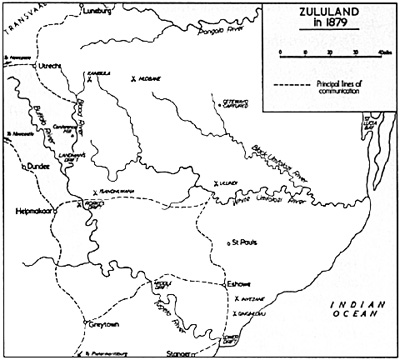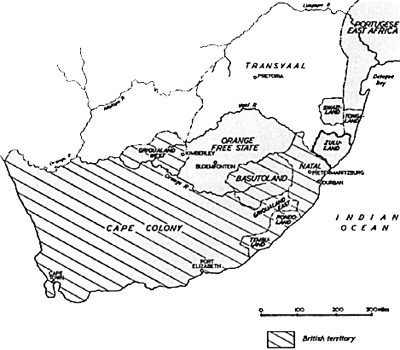Yes, you have beaten us," an old Galeka warrior said... "You have beaten us well, but there," said he, pointing eastward -- "there are the Ama Zulu warriors! Can you beat them? They say not! Go and try. Don't trouble any more about us, but beat them, and we shall be quiet enough..
IN AUGUST 1878 the senior South African Commander, Lt General the Honorable Sir Frederick Augustus Thesiger, a veteran of the Indian Mutiny and the Abyssinian Campaign and instrumental in the more recent bush war of the Eastern Cape Frontier against the Galeka, soon to become Lord Chelmsford upon his father's death in October, was ordered to prepare a report by Frere, detailing the Zulu armies' strength, Natal's military situation and the forces required to invade Zululand.
Chelmsford's report advised an invasion with a swift decisive campaign, as any military defence of Natal would be hopeless with its miles of border and many potential crossing points for a Zulu impi. Initially, he planned an invasion based on 5 separate columns, all converging on Ulundi, the Zulu capital; this was to be changed to 3. Separating his force and allowing their commanders to act independently was possibly a concern to him, but he knew he had to engage the Zulu army in an early decisive battle.
The 3-pronged advance gave a better chance of contact and allowed a speedier advance across the roadless vastness of Zululand and also acted to screen Natal and the Transvaal's borders by advancing over a wider area. The now redundant 4th and 5th columns would remain guarding the borders, available, if required, for the advance. Worries of an attack by a Zulu impi across the border was high.
Detail
Chelmsford went into great detail in his preparation for war, issuing each senior officer and company officer with a detailed booklet on the Zulu armies' strengths, structure and tactics. He sought information on the topography of Zululand and was aware of the Boer engagements with the Zulus.
Another pamphlet was published, Regulations for Field Forces in South Africa, giving orders covering encampments, transport, commissariat and virtually everything else an invading force should need to do. Lastly, a pamphlet for Suggestions for the General Management of Horses and Mules was detailed by a veterinary surgeon. Britain had never before gone to war with such a detailed knowledge of a native foe and its country.
By January 1879, Chelmsford had assembled the force below:
85 Staff and Departments, 263 Royal Artillery, 20 guns, 2 rocket tubes, rocket troughs, 5,128 infantry, 1,192 cavalry, 315 mounted natives, 9,035 Native Contingent, 1,910 conductors, drivers and foreloopers, 10,023 oxen, 803 horses, 398 mules, 977 wagons, and 56 carts total, 17,929 officers and men.
Column Invasion Points
No. 1 column Lower Drift C/O Col. Pearson, 3rd Foot.
No. 2 Column Mdale Drift. C/O Lt-Col. Durnford RE (to guard Drift and patrol border).
No. 3 Column Rorke's Drift. C/O Brevet Col. Glyn, 24th Foot.
No. 4 Column Bemba's Kop. C/O Brevet Col. Evelyn Wood 90th Foot.
No. 5 Column Luneburg. C/O Col. Rowlands, 34th Foot. (Guarding and watching Boers in the Transvaal).


Back to Colonial Conquest Issue 1 Table of Contents
Back to Colonial Conquest List of Issues
Back to MagWeb Master List of Magazines
© Copyright 1992 by Partizan Press.
This article appears in MagWeb (Magazine Web) on the Internet World Wide Web.
Other military history articles and gaming articles are available at http://www.magweb.com